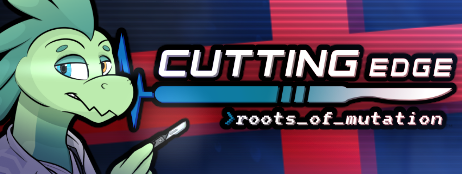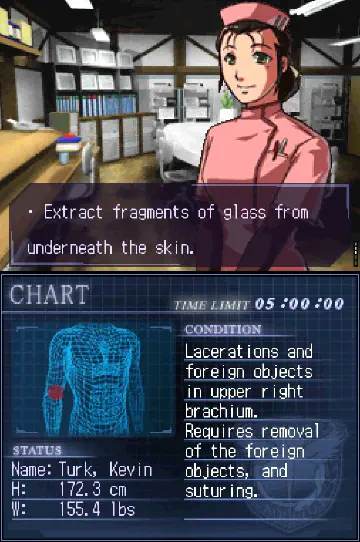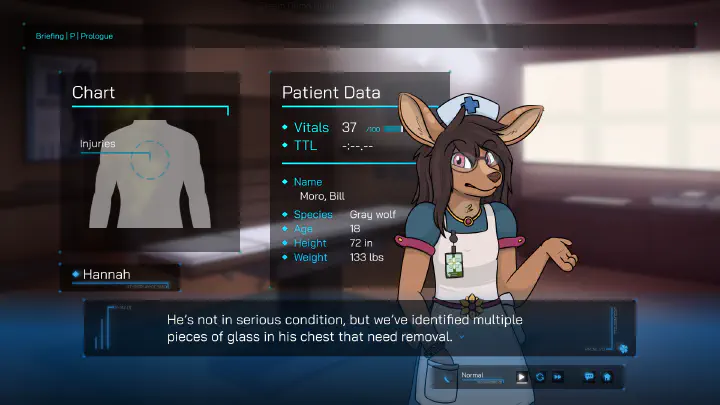Cutting Edge: Roots of Mutation Demo Thoughts

Note: This post will contain spoilers for the whole demo of Cutting Edge: Roots of Mutation. The start of the spoiler section will be marked.
Cutting Edge: Roots of Mutation’s demo (hereafter CE:ROM) came out recently, and I liked it enough to set up a separate blog just to talk about it a bit more. Building upon the surgeon sims that came before it, it manages to quickly establish itself and the new things it brings to the (operating) table.
This game plays a lot like Trauma Center - both games are a cross between a surgeon sim and a visual novel with increasingly higher stakes. Imagine Ace Attorney but for surgery. If you’re unfamiliar with both, you now have two additional fun series to consider playing.
You swap between a variety of tools and curing ailments involves playing a small dexterity challenge with one of the tools. Cutting along lines with the scalpel, draining fluids by clicking and dragging up, extracting bits and pieces with forceps without hitting anything else, and so forth.
CE:ROM however intends to do one better, and the prologue mission feels like it’s aimed straight at Trauma Center fans to let you both know what will be familiar and where it’ll be completely different.
Spoilers for the demo, and some early portions of Trauma Center, start here. If you’ve enjoyed Trauma Center I strongly recommend just picking up the demo at this point instead of reading further, because it does a ton of cool things that are great to experience firsthand.
You start off as Peri Maddock, an established surgeon with an amazing track record. They also have an experimental cybernetic eye. The prologue’s premise is that you will be doing an operation while the company that developed their eye, Kobold MediTech, will be recording and watching your operation. The operation in question is a trauma patient coming in from a motor vehicle accident. If this sounds familiar to you, congratulations! You are a cool person.


That’s right, it’s (almost) the same first case as Trauma Center! What a nice throwback to ease back into it. A familiar HUD pops up for vital signs and areas to operate on, except this time it’s courtesy of the cybernetic eye. I love when the writing accounts for gameplay elements. This also has some interesting implications for the writing, because now you could come up with believable reasons why the HUD would be inaccurate, but I digress. You’re supposed to remove some glass and stitch up some cuts, just like you might have done… 20 years ago? Trauma Center: Under the Knife is 20 years old? Ouch.
You complete the operation as you would expect, except the patient isn’t stabilizing. That’s different. You have to make some extra incisions. That is also different, and concerning. For lack of a better explanation, it appears your eye is malfunctioning. Wow, I can’t believe we’re already capitalizing on the potential of the scenario so early. Trauma Center usually takes a while.
As the eye keeps instructing you to make more cuts while Peri is doing worse by the moment, they almost end up killing the patient and get their medical license suspended for a year. They end up with trauma, severe self-worth issues and an aversion to cybernetics, which in their time away have practically taken over the whole medical field. They - and the player - come back to a world of surgery that is completely foreign.
This is how CE:ROM immediately carves out its own niche, and it does so really well. When I read Trauma Center with non-human anatomy and cybernetics, I expected them to take a backseat role and mostly enrich the operations’ minigame component. But cybernetics play a massive central role in the identity of the game, and its characters.
With Peri’s aversion to cybernetics and their newfound taste of failure and responsibility, they come back to a medical world that pressures its staff to augment themselves or fall behind. You eventually get a demo of what a CyberDoc - the game’s nomenclature for augmented surgeons - can actually do. For dramatic effect, this reveal is only talked about for a while before the game finally shows you.
Often, when a game presents a higher class of character, they perform some kind of grand feat to show off the gap between you and end-game greatness. However, in a skill-based game, there’s the risk that you may be already capable of pulling something similar off as a player, or in an RPG, it’s something you know you’ll be able to do at a higher level. It’s difficult to get it right, and the presentation falls flat as a result.
CE:ROM is different. When the time finally comes to see a CyberDoc in action in-game, their actions happen off-screen for a bit still, to build tension. They seem to be doing well, but you don’t see it happen directly. Eventually, the operation presents you with an impossible challenge and the CyberDoc steps in on your behalf on-screen this time; you get the equivalent watching a tool-assisted speedrun. An impossible amount of operations blink away while it sinks in: You can’t reach this level as a player. And like Peri, you feel that. This isn’t some obstacle that a little story progression will fix for you, it’s genuinely insurmountable in terms of speed and efficiency. This makes Peri’s self-worth problems reflect compellingly in gameplay that not a lot of other games can pull off. Amazing execution. No notes.
It drives the sense of helplessness home. How will you (Peri and the player both) find your identity when you’ve gone from top surgeon by prologue/Trauma Center standards to unable to compete in the field with even augmented rookies? Why aren’t you getting more augmentations? Surely you want to give your patients the exceptional care they deserve?
Story-wise, CE:ROM asks all the right questions - where is the line between medicine and cybernetics, would you augment yourself if you could help more people, is it acceptable for these parts to fail if the surgeons get better, you name it. There’s a look at the business side of things, and it’s believably written; there’s a chapter where Spark, the technician (that I really hope I can trust because I like him), repurposes some of Kobold MediTech’s better-selling chips into ones that are required for older cybernetics, because they don’t sell the chips for those anymore. Except both chips are almost functionally identical. They stopped selling the older type to (allegedly) compel people to replace their whole organ instead of just a part, which is more lucrative. This is something we already see a lot for electronics in general. Details like that really sell the story and setting for me. And that’s still the first demo chapter.
The characters we’ve seen so far are strongly written and a joy to see. Of course there’s Peri, and they’re brilliant. They can function both as a veteran and a tutorial character, which is completely intentional. Like their predecessors from other games, they have a strong sense of responsibility and wants to help people. But the cybernetics add a layer to that with a lot of writing opportunities that are thankfully in the hands of a competent writer.
Spark, the technician for the cybernetics on your side, is great because the writing really nailed the tech mindset - he can fix it, but outside of medical protocol, and not without unforeseen issues. He brings a manually soldered and unshielded device to reprogram medical hardware, which believably looks like something you’d put together for UART flashing. I suspect the writer has done this before. This mindset works for software, but what if lives are at stake? Again, the writing does not drop the ball here and was way ahead of me.
There’s Dr. Larsen, the aforementioned first CyberDoc you encounter. In addition to being highly revered, he’s augmented, lightning-fast because of it, tasked with Peri’s assessments for their re-integration into surgery, and disapproving of Peri’s lack of cybernetics. However, his cybernetic arms have been failing more recently. It should be a greater concern, but no one wants to readily acknowledge the downsides to cybernetics as some have built their identity around this higher functioning. Interesting stuff.
We also have Nurse Brooke. She’s an ally to Peri and their aversion to further bodily augmentation, though she acknowledges the better care they can provide for their patients with augments. Until finding out about Peri’s eye model, which sets her off, and you lose your only ally (for a bit). This alienates Peri even further. The hooks just keep on coming.
Everyone has a well defined part to play in the story, and believable characterization. The events and developments feel real. The writing is genuinely interested in what a medical-cybernetics crossover would look like and what its implications are, and it had me hooked. I had a blast reading the demo story. It’s off to a very strong start.
The gameplay is like Trauma Center, but once again cybernetics change a lot in this regard. You have to defer to others on how to fix them, because you never got training during your suspension. Some of it is just removing or putting back screws, and you don’t want to over-tighten them. There’s soldering where you don’t want to under- or overheat for maximum points. These are both cool additions.
Sometimes it’s simply replacing burnt out parts, but pay attention! Your technician might have forgotten in which order the parts go back. Eventually, you are presented with a situation where no one knows what to do, and no amount of cybernetic speed can help you. You’ll have to apply some creative problem solving to remind everyone in the room that Peri Maddock is not ready for replacement quite yet. As always, a solid pitch and a hit from the writing, and the visual novel portions and the gameplay strengthen each other. You do feel yourself clawing back from the depths of this cybernetic pit a little by solving this small puzzle.
The cybernetics change a lot in the story, but also provide many opportunities for unique gameplay that you can’t find in Trauma Center. Different types of surgeries, but also a few augmentations in the demo - they’ll give you specific buffs and debuffs to suit your gameplay style. The story implications of those are reserved for outside the demo, but they’re a fun idea and I would like to see where they go with them.
It bears mentioning that the game comes with 3 distinct difficulty settings, rankings and a leaderboard as a means to challenge yourself. I definitely went back a few times to see if I could do better, so it worked on me. There’s an amount of challenge for everyone.
With most of the attention going to writing and gameplay, it feels unfair to ignore the art and music - both of which are solid, to make for a complete, polished package. I love the character designs, and the music hits the right middle ground for upbeat visual novel music and operating tension, like the games that came before it. The art direction is solid and readable, which is again very much intentional. It truly has it all.
CE:ROM understands well what makes Trauma Center good and fun to play, and adds and explores a new dimension to great effect. The setting is established quickly, and its sprawling consequences slowly become apparent. It uses its predecessors as a springboard to dive right into the heart of the matter, playing with your expectations along the way. Hard to believe this is the dev’s first game release, I’m very excited. Also incredible and worth mentioning that this is a solo dev effort. What a legend.
All in all, I’m definitely getting the full game the moment it comes out. I’m eager to see the rest of the story unfold, and see what operating challenges the developer will cook up.
If this sounds like your jam, definitely wishlist the game or play the demo and consider following the developer for more information.